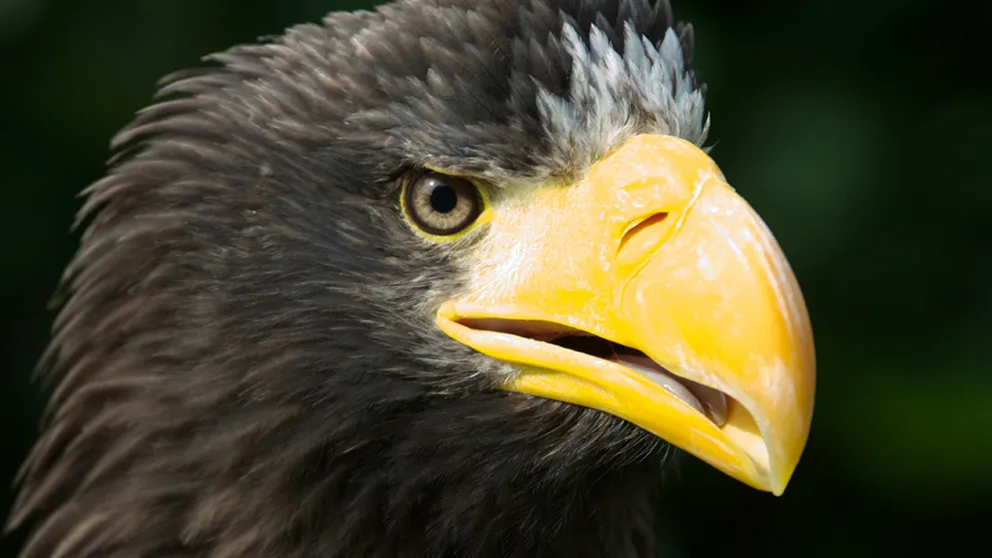Bird watchers in awe over lost Asian eagle’s journey across US
It's unknown where this particular Steller’s sea-eagle originated, but it was first recorded in Matanuska-Susitna County, Alaska, on Aug. 30, 2020
Steller's sea-eagle spotted around New England
The sighting of a rare eagle is stirring up a lot of excitement among bird watchers. The Steller's sea-eagle has been spotted in Boothbay Harbor, Maine.
BOOTHBAY HARBOR, Maine – Thousands of miles away from its home, the sighting of a rare Asian eagle is stirring up a lot of excitement among bird watchers in the United States.
It's unknown where this particular Steller’s sea-eagle originated, but it was first recorded in Matanuska-Susitna County, Alaska, on Aug. 30, 2020. Recently, it was spotted along the Sheepscot River in Boothbay Harbor, Maine. Last month, this same eagle was seen in Taunton, Massachusetts.
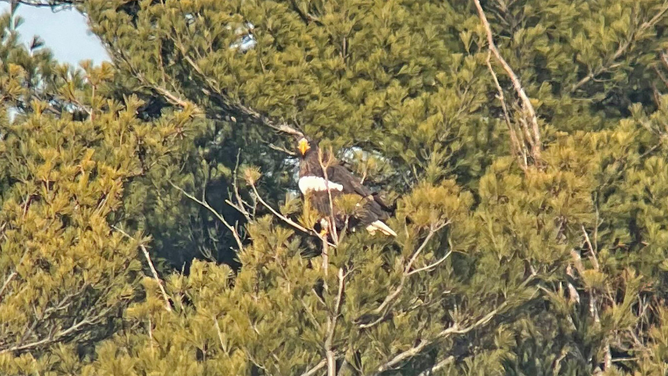
Jeremiah Trimble photographed a Steller's sea-eagle at Assonet Bay, Massachusetts, on Dec. 20, 2021.
(Jeremiah Trimble)
It's a species native to Asia, specifically Japan, Korea, China and the eastern tip of Russia.
"Most of the world’s Steller’s sea-eagles breed on and near the Kamchatka Peninsula of Russian Siberia and winter south to northern Japan," said Jeff Wells, vice president of the National Audubon Society’s Boreal Conservation program.
The Steller’s sea-eagle is also considered vulnerable. Wells estimates there to be just 4,000-6,000 remaining with the population in decline.
A timeline of the journey
- Aug. 30, 2020: Matanuska-Susitna County, Alaska
- March 10, 2021: Coleto Creek Reservoir, Victoria, Texas
- June 28, 2021: Gaspé Peninsula, Quebec/New Brunswick, Canada
- Nov. 3-4, 2021: Avon River, near Falmouth, Nova Scotia
- Dec. 12-20, 2021: Taunton River, Massachusetts
- Dec. 20, 2021 – Jan. 6, 2021: Sheepscot River, Maine
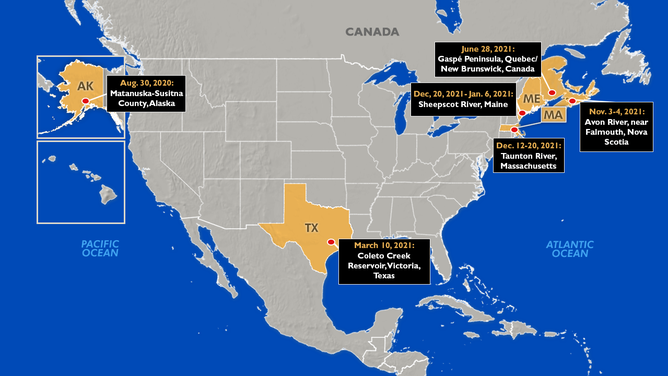
(FOX Weather)
Wells said hundreds of people traveled from all over Maine, the eastern U.S. and perhaps some from even farther away, to see the globally rare bird during its last known sighting.
An eagle's beauty
The Steller's sea-eagle is one of the biggest raptor species in the entire world weighing up to 20 pounds with a wingspan of eight feet.
"Picture a bald eagle and then basically double it in size, which is a massive bird," said Marshall Iliff, the eBird project leader at the Cornell Lab of Ornithology.
But its beauty doesn’t stop there. From its huge bright yellow bill, to distinctive color distribution of white and dark-brown body feathers and a large white blaze on the wings, it’s a real dramatic bird.
AUDIO: LISTEN TO STELLER'S SEA EAGLE VOCALIZING IN DIGHTON, MASSACHUSETTS
But how it got from Asia to the U.S. is the million-dollar question.
Iliff said there's a lot of birds that turn up outside their normal range.
"But this one is so far from its normal range that it's kind of blowing everyone's mind," Iliff said.
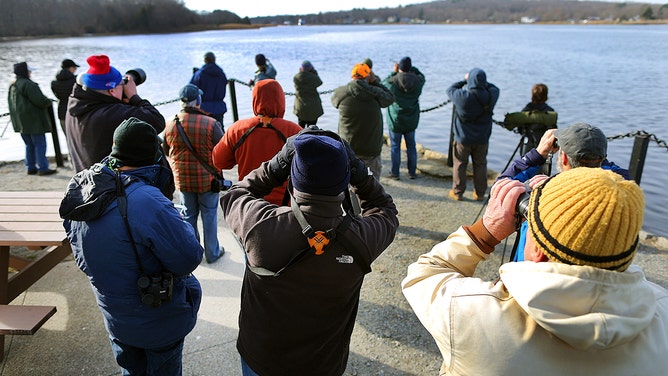
Birdwatchers and photographers flocked to Dighton Rock State Park on Dec. 21, 2021, to try and catch a view of the Steller's sea eagle native to Asia that was spotted along the Taunton River there the day prior.
(John Tlumacki / Getty Images)
The Steller's sea-eagle has a long history of turning up in Alaska and either staying in the state or maybe even flying back to Russia.
"This is the first individual that's ever shown up in North America outside of Alaska, and it's done it in sort of this grand fashion of going to three different states now and three different provinces in Canada," Iliff said.
Raptors are explorers
A lot of small birds will migrate with tailwinds.
"So when you get southwesterly winds, we see birds from the southwest, sometimes overshooting or coming here with the strong tailwind," Iliff said.
Weather also has a big factor during hurricanes. Not so much small birds, but seabirds can get caught in the vortex of hurricanes and displaced long distances.
Yet big soaring birds, like raptors, rarely have a real weather tie.
"There's just this innate wanderlust that some birds have. They're the explorers, they're the ones that just end up doing something totally different," Iliff said.
While it is very possible that favorable winds helped this particular bird get from Russia to Alaska, how it’s traveling now probably has more to do with choice and individual decisions rather than the weather.
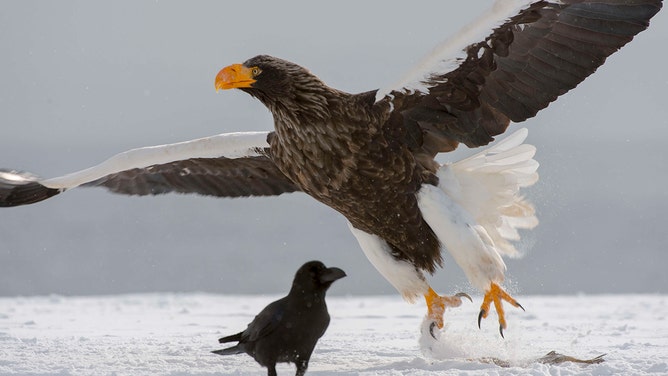
A Steller's sea eagle takes off from snowy ground near Rausu, a small fishing town which is located on the east end of the Shiretoko Peninsula on Hokkaido Island, Japan.
(Wolfgang Kaehler / Getty Images)
Iliff believes weather is not likely to be a factor in the appearance of this eagle in the Lower 48 and Atlantic Canada, but it may influence some of its movements within the continent.
"In particular, the Texas record is quite surprising but makes more sense in the context of occurring shortly after the epic cold snap there last spring," Iliff said.
While it does make sense that this raptor would be in Canada in the summer and New England in the winter, those are typical migratory movements for this kind of bird.
"It's just kind of moving where it wants to," Iliff said.
There's never really been a bird that's quite captured birders like the Steller's sea-eagle with the thrill of the chase and big mysteries like this one has.
So if you are able to spot it in the wild, take a moment to marvel at its beauty because it's a spectacular thing to witness.
